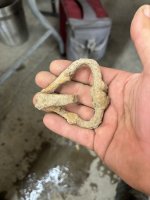Patriot Relics
Silver Member
- Feb 6, 2014
- 3,708
- 5,569
- 🥇 Banner finds
- 5
- Detector(s) used
- CTX-3030, Deus XP II
- Primary Interest:
- Relic Hunting
Hey guys,
Been MIA on TNet for a few weeks while flying back and forth from the desert. My new site has produced some crazy finds recently...colonial gold ring, rattlesnake, and a counterfeit 2 escudos to name a few...so I was itching to get back out. Before I left, a good buddy Brad (OutdoorAdv) offered to cook a bit of iron for me from the site and the results did not disappoint. Arriving home and opening the iron package was basically relic hunter Christmas
Here's the before (cannon ball was a recook from a previous dig)
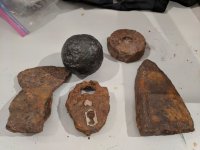
After electrolysis and a wax seal
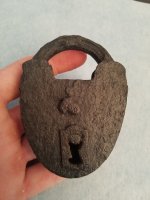
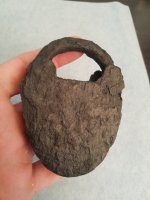
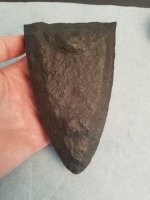
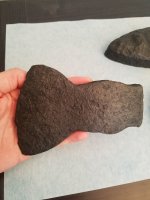
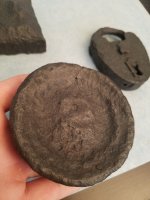
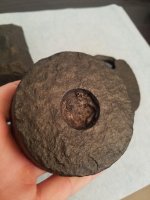
Hard to choose favorites, but the 2 pound (lead filled) plantation scale weight is pretty cool. Huge thanks for Brad for his time and efforts.
Back to yesterday evening's dig- got back on the same section of dirt that had produced the early 1700s scatter. This was my first target with the HF elliptical coil among the iron
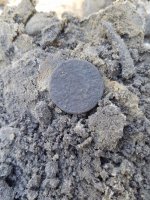
I've been fortunate to dig the half penny and the twopence varieties, but this penny rounds out the set. A bit of background William Wood, owner of several copper and tin mines, hoped to make a profit producing coins for use in Ireland and America. Through the king's mistress, the Duchess of Kendal, he was able to obtain a royal indenture to produce coins for Ireland on June 16, 1722. Soon thereafter the Duchess assisted Wood in obtaining a second indenture on July 22, 1722, authorizing him to produce one hundred tons of coins for the American colonies over a period of fourteen years for an annual fee of £300 to the king (£100 in rent directly to the king and £200 to the clerk comptroller) . The coins were made of an alloy called Bath metal composed of 75% brass, 20% zinc (mixed with tin and bismuth) and 5% silver and were to weigh slightly less than half the weight of English coins. The Bath metal planchets had to be hot when they were impressed between the dies to keep the dies from cracking. The heating of the planchets caused gas bubbles to form in the metal, as the planchets were struck while they were hot, these small bubbles did not have a chance to escape and therefore they produced a porous surface on the coins, often with some discoloration. Wood was authorized to make 120 halfpence to the pound (compared to forty-six halfpence to the pound at the Tower of London mint) which, according to Mossman, would yield a 140% profit after adjusting for production costs. Unfortunately, Wood had been required to pay the Duchess of Kendal £10,000 for his Irish indenture (apparently no additional charge was incurred for the American colonial indenture) so he was forced to mint his coins at an even lower weight in order to return a profit! These lightweight coins were not accepted by the colonists. Wood's penny was similar to a London halfpenny and his halfpenny was like the farthing, while his twopence did not correspond in weight to any currently circulating coin. In New York, merchants refused to accept the coins, while the General Assembly of Massachusetts in June of 1722 authorized the printing of £500 in one penny, two pence and three pence paper bills, rather than accept the Rosa Americana coins! Nevertheless, some colonies did accept them, although only reluctantly and only in limited quantities. Among fifty-nine coins found during the restoration of Colonial Williamsburg, two were Rosa Americana pennies dated 1722.
Because his coins were not accepted, and therefore no profits could be realized, Wood stopped minting coins in 1723. A few pattern Rosa Americana coins were produced in 1724, and after Wood's death in 1730, an undated twopence pattern was produced (assigned to 1733) by the successors to his coining patent; no further large scale minting was undertaken.
Here's the toothpick cleaning progression - 1722 Rosa Americana Penny
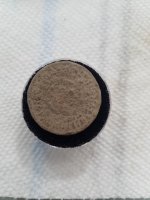
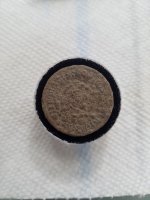
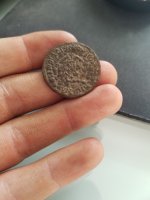
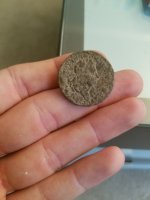
3 varieties reunited
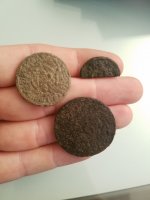
Did have a bit of success with buttons as well- this 1 piece patriotic eagle is the 3rd from the site
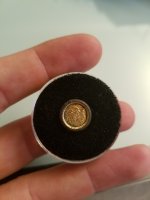
One piece gilt with paste stone inlay
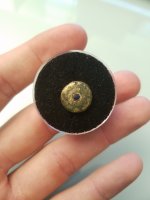
The best flats
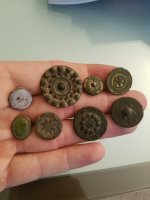
Also dug a horse curb chain
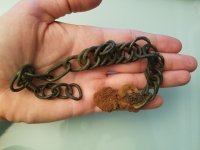
Thimbles
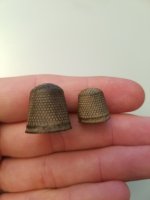
That about covers the spread, adding another rare copper certainly scratches the itch. Looking forward to getting back out in the dirt this weekend. Thanks for you comments and for looking.
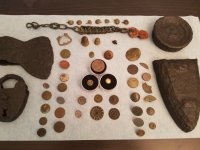
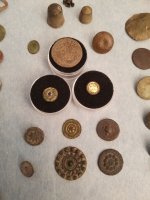
Been MIA on TNet for a few weeks while flying back and forth from the desert. My new site has produced some crazy finds recently...colonial gold ring, rattlesnake, and a counterfeit 2 escudos to name a few...so I was itching to get back out. Before I left, a good buddy Brad (OutdoorAdv) offered to cook a bit of iron for me from the site and the results did not disappoint. Arriving home and opening the iron package was basically relic hunter Christmas

Here's the before (cannon ball was a recook from a previous dig)

After electrolysis and a wax seal






Hard to choose favorites, but the 2 pound (lead filled) plantation scale weight is pretty cool. Huge thanks for Brad for his time and efforts.
Back to yesterday evening's dig- got back on the same section of dirt that had produced the early 1700s scatter. This was my first target with the HF elliptical coil among the iron

I've been fortunate to dig the half penny and the twopence varieties, but this penny rounds out the set. A bit of background William Wood, owner of several copper and tin mines, hoped to make a profit producing coins for use in Ireland and America. Through the king's mistress, the Duchess of Kendal, he was able to obtain a royal indenture to produce coins for Ireland on June 16, 1722. Soon thereafter the Duchess assisted Wood in obtaining a second indenture on July 22, 1722, authorizing him to produce one hundred tons of coins for the American colonies over a period of fourteen years for an annual fee of £300 to the king (£100 in rent directly to the king and £200 to the clerk comptroller) . The coins were made of an alloy called Bath metal composed of 75% brass, 20% zinc (mixed with tin and bismuth) and 5% silver and were to weigh slightly less than half the weight of English coins. The Bath metal planchets had to be hot when they were impressed between the dies to keep the dies from cracking. The heating of the planchets caused gas bubbles to form in the metal, as the planchets were struck while they were hot, these small bubbles did not have a chance to escape and therefore they produced a porous surface on the coins, often with some discoloration. Wood was authorized to make 120 halfpence to the pound (compared to forty-six halfpence to the pound at the Tower of London mint) which, according to Mossman, would yield a 140% profit after adjusting for production costs. Unfortunately, Wood had been required to pay the Duchess of Kendal £10,000 for his Irish indenture (apparently no additional charge was incurred for the American colonial indenture) so he was forced to mint his coins at an even lower weight in order to return a profit! These lightweight coins were not accepted by the colonists. Wood's penny was similar to a London halfpenny and his halfpenny was like the farthing, while his twopence did not correspond in weight to any currently circulating coin. In New York, merchants refused to accept the coins, while the General Assembly of Massachusetts in June of 1722 authorized the printing of £500 in one penny, two pence and three pence paper bills, rather than accept the Rosa Americana coins! Nevertheless, some colonies did accept them, although only reluctantly and only in limited quantities. Among fifty-nine coins found during the restoration of Colonial Williamsburg, two were Rosa Americana pennies dated 1722.
Because his coins were not accepted, and therefore no profits could be realized, Wood stopped minting coins in 1723. A few pattern Rosa Americana coins were produced in 1724, and after Wood's death in 1730, an undated twopence pattern was produced (assigned to 1733) by the successors to his coining patent; no further large scale minting was undertaken.
Here's the toothpick cleaning progression - 1722 Rosa Americana Penny




3 varieties reunited

Did have a bit of success with buttons as well- this 1 piece patriotic eagle is the 3rd from the site

One piece gilt with paste stone inlay

The best flats

Also dug a horse curb chain

Thimbles

That about covers the spread, adding another rare copper certainly scratches the itch. Looking forward to getting back out in the dirt this weekend. Thanks for you comments and for looking.


Amazon Forum Fav 👍
Upvote
35







